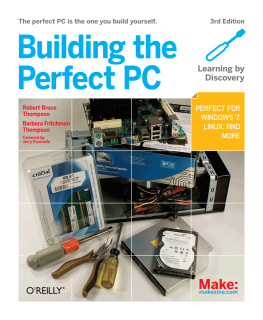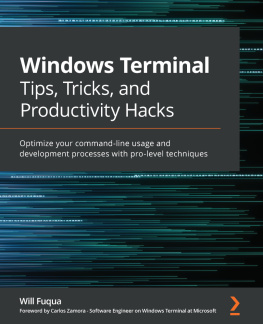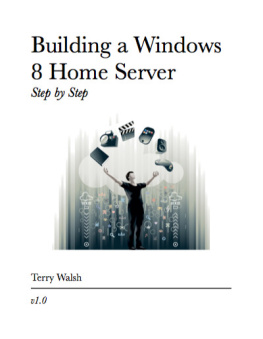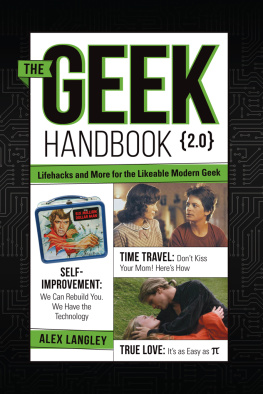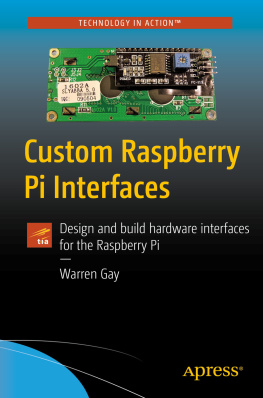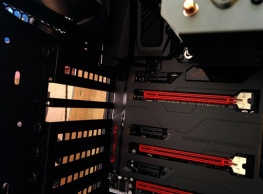Building the Perfect PC
Third Edition
Robert Bruce Thompson
Barbara Fritchman Thompson
Beijing Cambridge Farnham Kln Sebastopol Tokyo

Building the Perfect PC, Third Edition
by Robert Bruce Thompson and Barbara Fritchman Thompson
Copyright 2011 Robert Bruce Thompson and Barbara Fritchman Thompson. All rights reserved.
Printed in Canada.
Published by OReilly Media, Inc., 1005 Gravenstein Highway North, Sebastopol, CA 95472.
OReilly Media books may be purchased for educational, business, or sales promotional use. Online editions are also available for most titles ( http://my.safaribooksonline.com ). For more information, contact our corporate/institutional sales department: 800-998-9938 or corporate@oreilly.com .
Editor: Brian Jepson
Production Editor: Rachel Monaghan
Copyeditor: Rachel Head
Proofreader: Rachel Monaghan
Indexer: Angela Howard
Cover Designer: Mark Paglietti
Interior Designer: Ron Bilodeau
Illustrator: Robert Romano
Print History:
August 2004: First Edition.
December 2006: Second Edition.
November 2010: Third Edition.
The OReilly logo is a registered trademark of OReilly Media, Inc. Many of the designations used by manufacturers and sellers to distinguish their products are claimed as trademarks. Where those designations appear in this book, and OReilly Media, Inc., was aware of a trademark claim, the designations have been printed in caps or initial caps.
While every precaution has been taken in the preparation of this book, the publisher and authors assume no responsibility for errors or omissions, or for damages resulting from the use of the information contained herein.
ISBN: 978-1-449-38824-9
[TI]
To Mark Brokering, who came up with the idea and kept the ball rolling.
Foreword to the Third Edition
A lot has changed in the computer world since the last edition of this book, and even more since its first edition. Computers have become more powerful: when I wrote the foreword for the first edition, I had over 20 networked desktop computers, far more than I needed, but networking was complex and I needed a full network so that I could understand networking problems. Today, either of the two desktops I use as main machines have more computing power and disk storage than did all my computers put together a few years agoand if I have a sudden need for a lot more storage or computing power, I have access to cloud computing that can supply far more.
There have been other changes since the last edition of Building the Perfect PC . Quad- and even hex-core processors (and the chipsets and CPU sockets to support them) have not only become commonplace, but pretty well required. Tiny Mini-ITX systems, formerly niche products, are mainstream. CRT monitorsbottleshave pretty well vanished, replaced by flat-panel LCD displays, some as large as TV sets used to be. Audio and video built in to the motherboard are now good enough for a lot more than they used to be, while some external video cards now do as much computing as the best CPUs did. Audio processing has changed dramatically. Memory has gone through transmogrifications from DDR to DDR2 (now giving way to DDR3). Solid-state drives are available for both laptops and desktops.
If youre contemplating building your own PC, you need to know about all this before you decide what to build. For that matter, you need to know whats going on before you buy a ready-built system, and other than in this book its hard to find all that information in one place.
The reasons for building your own PC havent changed a lot in the past decade. You build your own PC so that you will know more about it, how it works, whats probably wrong if something does go wrong, and just for the sheer satisfaction that youve got precisely the machine you want and need. But then, I covered all that in the foreword to the first edition, and those principles havent changed. If you dont know whether to build or buy, this is still the best book I know of that will help you make that decision; and if you do decide to build your own, you really need this book.
Chaos Manor
August 2010
Foreword to the Second Edition
I was asked to revise the foreword I wrote for the first edition of this book, but I found there was no need. A few details have changed, but the principles havent.
However, the details are important. My main systems at Chaos Manor now mostly run with dual-core (both Intel and AMD) CPU chips. Since the first edition of Building the Perfect PC , the video card scene has changed several times. Intel lost its dominance as the maker of the fastest desktop CPUs for the money. AMD took advantage of the Intel stumble and surged ahead to its highest market share yet. AMD and nVidia joined forces, and now AMD has bought ATI. Case designs have changed. We have both DDR and DDR2 RAM to contend with.
If you have the first edition, you know how important the book is, and when you contemplate building a new system, youll be wise to upgrade. And if you dont have the first edition, this remains the best book you can buy if youre building or planning to build a PC. Now read the foreword to the first edition.
Chaos Manor
August 2006
Foreword to the First Edition
I presume youre reading this because youve either just bought this book or youre thinking of buying it, so lets get that out the way now. Should you buy this book, or, having bought it, should you be happy you did? The answer is yes. If the subject of building your own computer interests youand why in the world are you reading this if it doesnt?then you need this book.
That out of the way, we can look at the broader question of whether you should build your own computers.
As I look around Chaos Manor ( http://www.jerrypournelle.com ) I see that I have over 20 computers, all networked, and I built nearly every one of them myself. The exceptions are Princess, an ancient Compaq desktop Professional Workstation running Dual Pentium Plus 200 MHz CPUs; a Mac; a TabletPC; and another laptop. No one in his right mind builds his own laptop or Tablet. I keep Princess because Ive had her for a decade, and she hasnt been shut down in more than a year, and I havent the heart to scrap her; besides, shes still useful for doing long web searches. Until fairly recently I had a Compaq Professional Workstation (Dual 750 MHz Pentium III) as my communications system, but I retired it a few months ago in favor of a new 3 GHz built here, and since then every server and workstation added to the Chaos Manor network was built here. Clearly I must like building systems and using them.
It wasnt always this way. Until a few years ago I had at least as many brand-name systems as home-built white boxes. Then came the consumerization of the PC industry. Manufacturers were forced into cost reduction after cost reduction. Some of those cost reductions were not wise. Some were disasters. Worse, component makers were themselves competing on cost. It became more and more difficult to build a quality line of PCs to sell at any realistic price.
It is still possible to buy quality computers. Youll pay for them, though, and sometimes having paid an arm and a leg, you still wont know what quality you have bought. There are still big companies with mission-critical tasks who are well advised to buy the very best machines from top-of-the-line companies, but most users and small businesses would be better advised to consider building their own, or having them built to specs by a trustworthy local shopand this book is indispensable when it comes to writing out those specifications.

